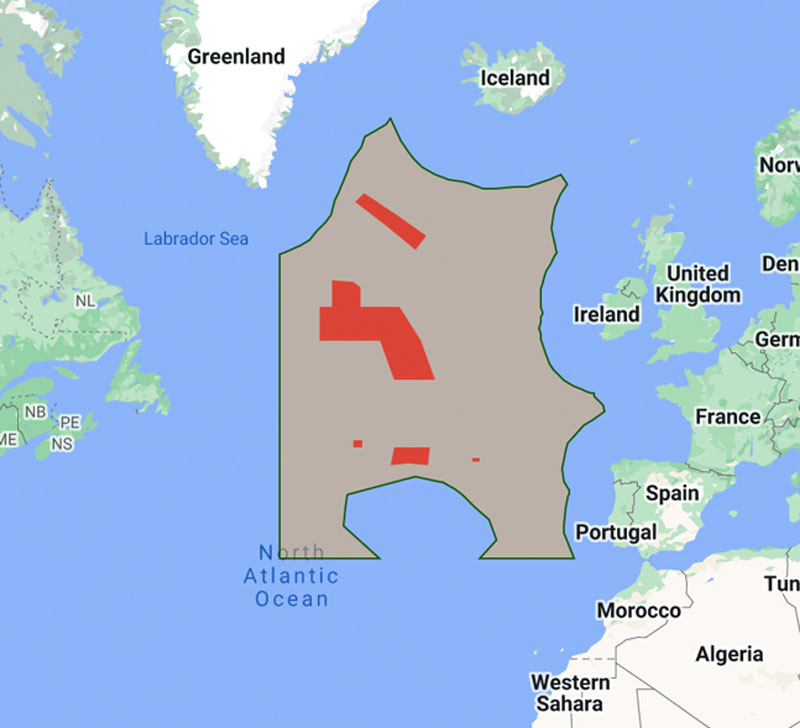Voyage to the Ridge 2022
May 14 - September 2, 2022
Voyage to the Ridge – Resource Use and Conservation
As noted in our introduction to high seas governance feature, a patchwork of sectoral organizations exerts fragmented authority over marine areas beyond national jurisdiction. There is no centralized mechanism to protect open ocean areas, and the state of high seas governance has been characterized by Dr. David Freestone as “an unfinished agenda. ” Below is a snapshot of the management measures over areas that will be explored during Voyage to the Ridge 2022.
Inter-governmental fisheries organizations with responsibility over the exploration area include:
- The Northwest Atlantic Fisheries Organization (NAFO) and the Northeast Atlantic Fisheries Commission (NEAFC), which are responsible for marine fisheries resources on the western and eastern sides of the North Atlantic respectively, with some exceptions such as salmon, whales, and tunas/marlins, which are the accounted for by other organizations.
- The International Commission for the Conservation of Atlantic Tunas (ICCAT), which is responsible for tuna and tuna-like species over the entire Atlantic Ocean.
The United Nations Food and Agricultural Organization (FAO) produces guidelines for designating “vulnerable marine ecosystems” (VMEs). Regional fisheries management bodies (RFMOs) are responsible for implementing these guidelines. RFMOs can adopt measures such as catch limits, restrictions on gear types, and the closing of certain areas to bottom fishing.
- NEAFC has closed several areas to bottom fishing within its regulatory area. Several within the Middle Mid-Atlantic Ridge (MAR) area , which are part of a VME are near the expedition track.
- NAFO has identified 27 VME sites within its regulatory area as vulnerable to bottom contact gears, and subsequently closed them to bottom fishing to all vessels.


There are also several OSPAR marine protected areas (MPAs) in the Voyage to the Ridge 2022 exploration area. OSPAR (named for the convention upon which it is based, an updated combination of the Oslo and Paris conventions against dumping and land-based pollution) is an intergovernmental organization cooperating to protect marine environments of the North-East Atlantic. OSPAR has the power to adopt MPAs “for the purpose of protecting and conserving species, habitats, ecosystems or ecological processes of the marine environment.”
- OSPAR has established a network of MPAs in the North-East Atlantic, including several on the Mid-Atlantic Ridge. The North Atlantic Current and Evlanov Sea basin (NACES) MPA aims to protect vital foraging sites for seabirds, and will be a focus of Voyage to the Ridge 2022 exploration.
- Facilitated by OSPAR, Portugal proposed the first national MPA under the high seas for the ‘Rainbow’ hydrothermal vent field , which is located in the Portuguese continental shelf beyond 200 nautical miles.

The International Seabed Authority (ISA) is authorized through the United Nations Convention on the Law of the Sea to regulate seabed mining activities in areas beyond national jurisdictions and are also mandated to protect and preserve the marine environment from impacts of mining activities. Among the environmental management activities undertaken by the ISA is the development of regional environmental management plans (REMPs). Because the northern Mid-Atlantic Ridge is host to polymetallic sulfides of commercial interest to miners, the ISA has drafted a REMP for this region.
Voyage to the Ridge 2022 will also pass through or nearby areas “described” by the Parties to the Convention on Biological Diversity (CBD) as ecologically or biologically significant areas (EBSAs), including the Sargasso Sea , the New England and Corner Rise Seamounts , Atlantic hydrothermal vent fields , and the slopes of the Flemish Cap and Grand Banks . The EBSA process is on-going, and not all EBSAs have been identified. While no regulatory or management activities are associated with EBSAs, EBSAs serve to highlight areas that merit consideration for conservation actions by competent authorities. Indeed, areas identified as meeting EBSA criteria were important in closure of the New England and Corner Rise Seamounts to bottom fishing, and EBSA criteria are proposed in the draft Mid-Atlantic Ridge REMP of the ISA to identify areas that might be closed to seabed mining activities.
The result of the Biodiversity in Areas Beyond National Jurisdiction (BBNJ) treaty negotiations, if adopted, will hopefully provide more internationally legally binding opportunities to protect these fragile high seas spaces – and expeditions like Voyage to the Ridge 2022 increase our scientific understanding of these ecosystems, which will be necessary if proposals are to be crafted for their protection.
By Fae Sapsford, Marine Research Fellow, Sargasso Sea Commission
Published July 22, 2022